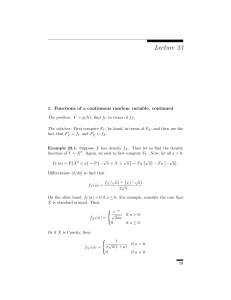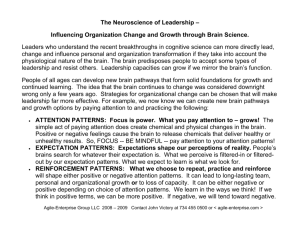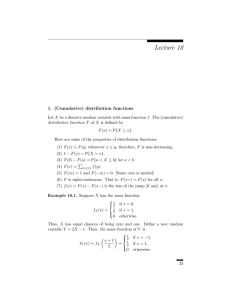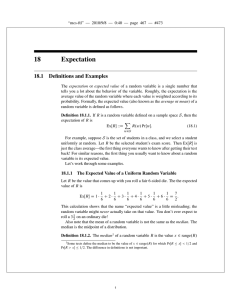Lecture 24 1. Functions of a random variable, continued
advertisement
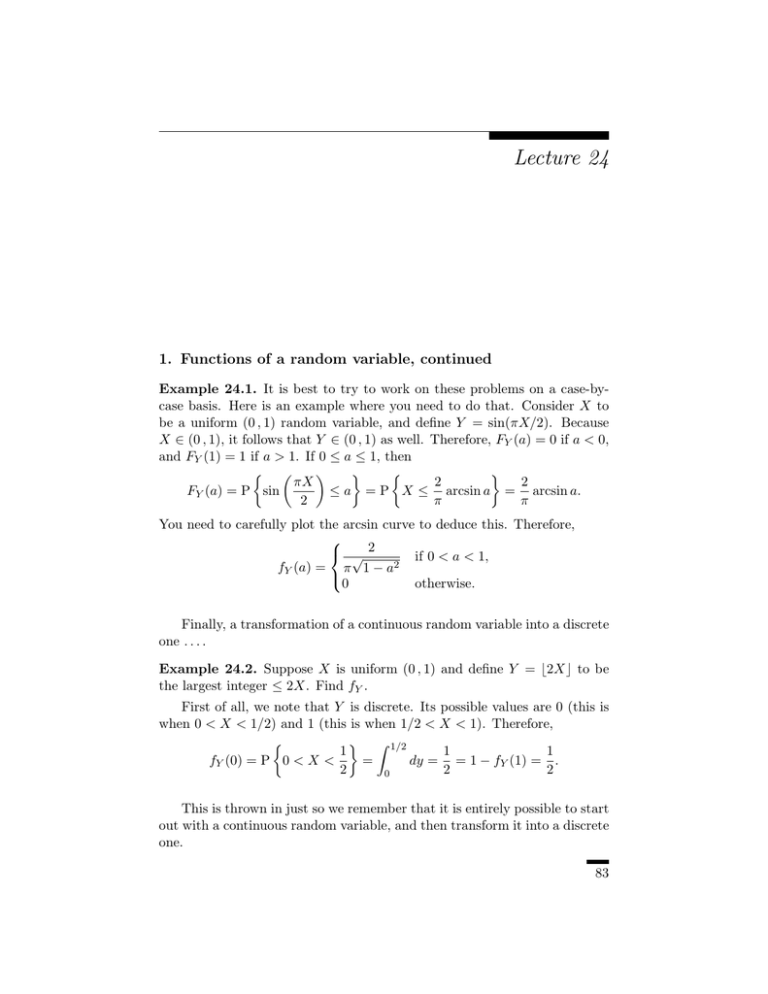
Lecture 24 1. Functions of a random variable, continued Example 24.1. It is best to try to work on these problems on a case-bycase basis. Here is an example where you need to do that. Consider X to be a uniform (0 , 1) random variable, and define Y = sin(πX/2). Because X ∈ (0 , 1), it follows that Y ∈ (0 , 1) as well. Therefore, FY (a) = 0 if a < 0, and FY (1) = 1 if a > 1. If 0 ≤ a ≤ 1, then ! " # $ ! $ 2 2 πX FY (a) = P sin ≤ a = P X ≤ arcsin a = arcsin a. 2 π π You need to carefully plot the arcsin curve to deduce this. Therefore, √2 if 0 < a < 1, fY (a) = π 1 − a2 0 otherwise. Finally, a transformation of a continuous random variable into a discrete one . . . . Example 24.2. Suppose X is uniform (0 , 1) and define Y = %2X& to be the largest integer ≤ 2X. Find fY . First of all, we note that Y is discrete. Its possible values are 0 (this is when 0 < X < 1/2) and 1 (this is when 1/2 < X < 1). Therefore, ! $ ( 1/2 1 1 1 fY (0) = P 0 < X < = dy = = 1 − fY (1) = . 2 2 2 0 This is thrown in just so we remember that it is entirely possible to start out with a continuous random variable, and then transform it into a discrete one. 83 84 24 2. Expectation If X is a continuous random variable with density f , then its expectation is defined to be ( ∞ E(X) = xf (x) dx, provided that either X ≥ 0, or )∞ −∞ −∞ |x|f (x) dx < ∞. Example 24.3 (Uniform). Suppose X is uniform (a , b). Then, E(X) = ( b x a 1 1 b2 − a2 dx = . b−a 2 b−a It is easy to check that b2 − a2 = (b − a)(b + a), whence E(X) = b+a . 2 N.B.: The formula of the first example on page 303 of your text is wrong. Example 24.4 (Gamma). If X is Gamma(α , λ), then for all positive values of x we have f (x) = λα /Γ(α)xα−1 e−λx , and f (x) = 0 for x < 0. Therefore, ( ∞ λα xα e−λx dx Γ(α) 0 ( ∞ 1 = z α e−z dz λΓ(α) 0 Γ(α + 1) = λΓ(α) α = . λ E(X) = (z = λx) In the special case that α = 1, this is the expectation of an exponential random variable with parameter λ. Example 24.5 (Normal). Suppose X = N (µ , σ 2 ). That is, " # 1 (x − µ)2 f (x) = √ exp − . 2 σ 2π 85 2. Expectation Then, " # ( ∞ 1 (x − µ)2 E(X) = √ x exp − dx 2 σ 2π −∞ ( ∞ 1 2 √ (µ + σz)e−z /2 dz (z = (x − µ)/σ) = 2π −∞ ( ∞ ( ∞ −z 2 /2 e σ 2 √ dz + √ ze−z /2 dz =µ 2π 2π −∞ * −∞ +, * +, 1 0, by symmetry = µ. Example 24.6 (Cauchy). In this example, f (x) = π −1 (1 + x2 )−1 . Note that the expectation is defined only if the following limit exists regardless of how we let n and m tend to ∞: ( n y dy. 2 −m 1 + y Now I argue that the limit does not exist; I do so by showing two different choices of (n , m) which give rise to different limiting “integrals.” First suppose m = n, so that by symmetry, ( n y dy = 0. 2 −n 1 + y Let n → ∞ to obtain zero as the limit of the left-hand side. Next, suppose m = 2n. Again by symmetry, ( −n ( n y y dy = dy 2 1 + y 1 + y2 −2n −2n ( 2n y =− dy 1 + y2 n ( 2 1 1+4n dz =− (z = 1 + y 2 ) 2 1+n2 z " # 1 1 + 4n2 = − ln 2 1 + n2 1 → − ln 4 as n → ∞. 2 Therefore, the Cauchy density does not have a well-defined expectation. [That is not to say that the expectation is well defined, but infinite.]
